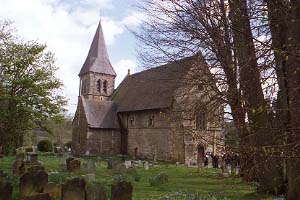|
History
of the village and early church
St. Nicholas' Church is a beautiful Saxon minster
dating from the late tenth century which is internationally famous
for its architecture. The fabric is in good order following a
serious fire in 1986 and the restoration [which took two years to
complete] has won several awards for the church's architect, Mr.
Geoffrey Claridge.
St Nicholas Church, Worth, is approached through a 16th century lychgate
(restored in 1956) and thence through a delightful avenue of
trees, sometimes known as the '10 Apostles'. It stands on its
pre-conquest foundations being one of the few existing buildings
to do so. It is a supreme example of a Saxon church built in the
style of the purely English cruciform churches which later became
general throughout the land. The semi-circular apse is unusual.
The church has retained these and other main feature, notably the
original powerful chancel arch, 3 Saxon windows and the arches to
the two transepts. Still to be seen, although somewhat differently
from their original form, are the Saxon archways forming the north
and south doorways.
At once,
however attention is drawn to the massive Saxon arch at
the east end of the nave. At 22' high
and 14' wide this is one of the largest pre-conquest arches still
standing. The strength of its appearance and ruggedness of
construction are at once beautiful and dominant, emphasising the
altar beneath.
Advancing from beneath the gallery look upwards
to see the three notable examples of Saxon windows, 2 on the north
side and one on the south. They are formed by twin arched light
separated by a stone baluster on square stone bases. These windows
are probably unique in that no others like them are known in the
nave of a church. They were set at a great height for a purpose.
In the troublesome times through which the church has lived,
especially pre-conquest, almost every church was used as a place
of safety to which people could flee for sanctuary afforded by the
solid walls of probably the only stone building in the district.
Such high windows offered further protection making it difficult
for marauders to gain access.
Close by are the north and south doorways with
their original Saxon arches. These vary lofty archways are
characteristic of late Saxon work. Some have it that the arches
were created in this form so that a horseman could ride into the
building, make obeisance to the altar or pray, without
dismounting, and be able then to ride through and out of the
opposite door without turning his mount. Whatever myths or truths
there may be in this, these days the north (or devil's)
door is filled in. Superstitions there may be about
blocking up the devil's doorway but the truth is likely to be the
practical effect of keeping out the cold draughts from the north!
The crucifix in this arch is 18th century and
probably Spanish in origin. At one time it was owned by a Bishop
of Lewes.
The 14th century south door occupies
only half the height of the original opening whilst the porch
beyond was added in 1886. Just to the east of this opening is a
holy water stoup of the 14th century. A further stoup of similar
date is beside the west door.
|

